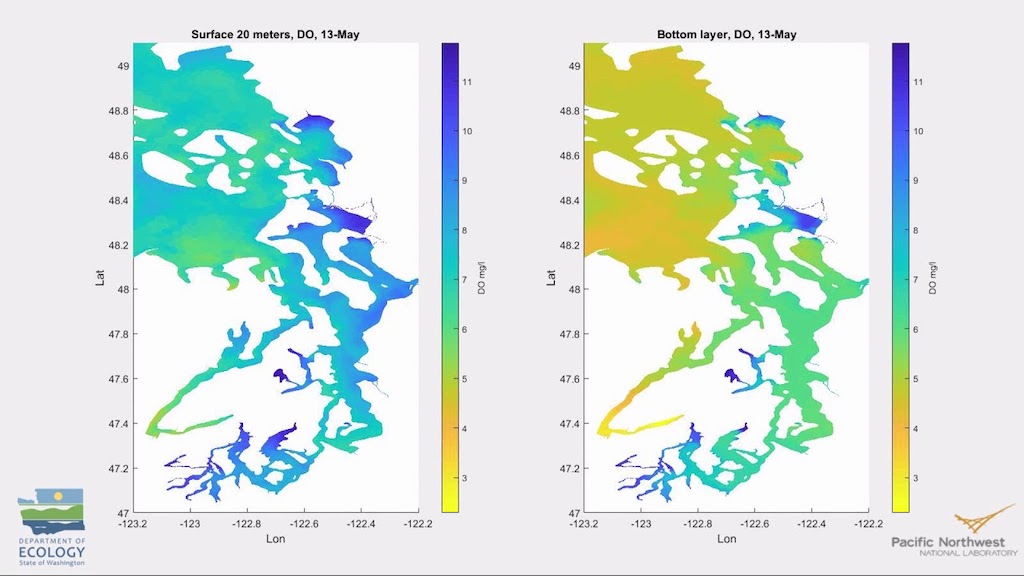The course of events that trigger low-oxygen conditions in Puget Sound is fairly well understood. A key factor involves excess nutrients, particularly nitrogen, that over-feed a large variety of plankton drifting through the water. When large numbers of these tiny organisms die and decay, the bacterial activity consumes available oxygen, which can lead to unhealthy or even lethal levels of oxygen affecting marine creatures.
It's a balancing act within a Puget Sound food web that depends on the growth of phytoplankton, tiny microalgae and plants that can generate their own energy from nutrients and sunlight. Phytoplankton are eaten by larger marine organisms, which are eaten by others in turn, and so on, up the food web. Organic carbon as well as nitrogen cycling through the food web may affect oxygen levels.
According to estimates from the Washington State Department of Ecology, two thirds or more of the nitrogen in Puget Sound comes from the ocean.
In proper balance, nitrogen is an essential ingredient in the diversity of life that exists in Puget Sound. Still, too much nitrogen can lead to massive plankton blooms, producing an overabundance of food that exceeds the consumptive capacity of higher organisms. When that happens, bacteria take over to break down the surplus biomass, which can lead to low-oxygen conditions.
While human sources of nitrogen may tip the balance, scientists point out that natural sources of nitrogen are abundant throughout Puget Sound. Alder trees and other nitrogen-fixing plants, along with wildlife contribute nitrogen to forest soils. These upland nitrogen sources, along with decaying plants and dead salmon, can make their way into streams before reaching Puget Sound. Even larger amounts of nitrogen circulate in the Pacific Ocean and enter Puget Sound through the Strait of Juan de Fuca. According to Ecology estimates, two thirds or more of the nitrogen in Puget Sound comes from the ocean.
From the land, human sources contribute about 2.6 times more nitrogen than natural sources, according to Ecology estimates. But the story becomes complicated by issues of time and location. When and where nitrogen enters Puget Sound can make all the difference. For example, winter months bring less sunlight and cooler temperatures to slow the growth of phytoplankton. At the same time, winter storms increase the mixing of fresh and salt waters, reducing the nitrogen concentration. Higher river flows in winter help to carry nitrogen out of Puget Sound.
In contrast, the sunny days of summer encourage the growth of plankton in the surface waters of Puget Sound. Nitrogen carried into the Sound by freshwater tends to stay at the surface due to its lower density and less mixing. Nitrogen-laden effluent discharged from pipes tends to rise as well. During the relatively calm seas of summer, layers of water may form with distinct differences in temperature, density and biological activity, a process called stratification which can influence oxygen concentrations at different depths.
In many estuaries throughout the world, including Puget Sound, the outflow of freshwater at the surface is driven by river flows. The outflow is counterbalanced by an influx of heavier saltwater creeping inward from the ocean along the bottom. Where the incoming, deep-moving saltwater encounters underwater ridges along the bottom, known as “sills,” the heavier saltwater gets churned up and pushed toward the surface. This is how some of the nitrogen-rich ocean water reaches the sunlit layer — the euphotic zone — where phytoplankton are busily growing and multiplying.
Meanwhile, the powerful, unrelenting tides push and pull huge masses of water throughout Puget Sound, including every inlet and channel. Seen from shore, the waters rise and fall twice each day, as tidal currents carry the water in and out of the inlets and back and forth through the channels.
All of this goes to show that a multitude of dynamic water movements must be accounted for in computer models designed to predict oxygen levels. Among the key questions: How much of the nitrogen entering Puget Sound gets consumed by plankton? How much of the plankton gets broken down by bacteria? And how much oxygen gets used up, not just overall but in specific locations throughout the Sound.



